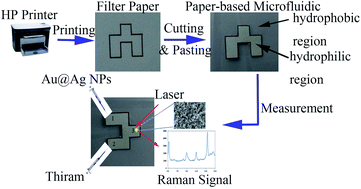Highly sensitive and label-free determination of thiram residue using surface-enhanced Raman spectroscopy (SERS) coupled with paper-based microfluidics†
Abstract
In this study, a paper-based microfluidic surface-enhanced Raman spectroscopy (SERS) device was employed for the determination of trace level thiram. The paper-based microfluidic device was fabricated by cutting a hydrophilic region which had been printed on the filter paper and then pasting it onto sellotape. The Au@Ag nanoparticles (NPs) were synthesized with a 30 nm Au core and 7 nm Ag shell and used as the SERS probe. The synthesized nanoparticles were dropped in one of the sample adding zones of the paper-based microfluidics and the thiram solution was dropped in another one. The solutions flowed through their own channels by capillary action and mixed together in the reaction chamber. The optimization studies on the use of paper-based microfluidic devices are discussed. In SERS measurements, the intensity of the peak at 1143 cm−1 was highly sensitive, and so it was chosen as an ideal peak for the quantitative analysis of the concentration of thiram solution. The limit of detection (LOD) of thiram was as low as 1.0 × 10−9 mol L−1, and the relative standard deviation (RSD) results analyzed at 10 random spots in the SERS measurement area were all below 10%. The recovery values of thiram in adulterated tea samples were from 95% to 110%. All these results suggest that this proposed method is a prospective candidate for trace level thiram detection.



 Please wait while we load your content...
Please wait while we load your content...